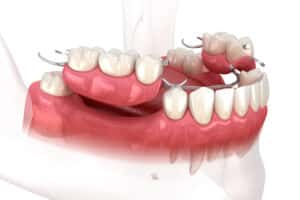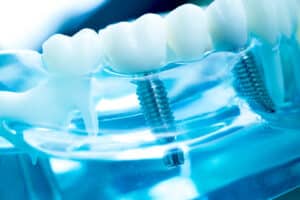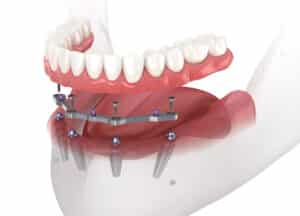Risks of Smoking with Dental Implants
Abstract:
Failure of dental implants to achieve osseointegration is often attributed to patient baseline variable, such as smoking. This meta-analysis examines outcomes of clinical studies that monitored the performance of machined-surfaced Osseotite dental implants; the analysis also isolates the effect of smoking. The dental implant data for the machined-surfaced dental implants are derived from three prospective studies (n= 2,274) for the Osseotite dental implants. All dental implant placement surgeries followed a two-stage surgical approach with an unloaded healing period of 4 to 6 months. An evaluation of the data sets (i.e. smokers vs. nonsmokers) was first performed to determine the existence of imbalance in baseline variables, including patient demographics, bone quality, location, dimensions, and types of prostheses. Analysis of the distributions of these baseline variables showed similar proportionalities and therefore qualified the data sets for comparison of the cumulative success rates (CSR) of the dental implants on the basis of smoking. For the 2,117 nonsmoking, machined-surfaced dental implants, the 3 year CSR is 92.8 %; for the 492 implants in the smoking group, the CSR is 93.5 %. The 3-year CSR for 1,877 nonsmoking Osseotite dental implants is 98.4%; for the 397 smoking dental implants it is 98.7%. No difference is observed between smoking groups and the nonsmoking groups in these patient populations. There is, however, a clinically relevant difference observed between the two dental implant types.
Despite rigid adherence to established protocols, certain groups of patients lose a disproportionately high number of endosseous dental implants. This clustering of failures concerns both patients and clinicians and leads to retrospective assessment of variables that may have contributed to the problem. These variables describe biologic and mechanical parameters considered to have an effect on dental implant functional longevity. In addition, they include the quality and quantity of available bone, dental implant length and location, the degree of initial fixation, and the amount of time allowed for healing between dental implants placement and prosthetic loading.
Systemic conditions identified as risk factors for dental implant failure include:
- Uncontrolled diabetes.
- Postmenopausal women not on hormone replacement therapy.
- Untreated osteoporosis.
- High levels of head and neck radiation.
- Alcoholism.
Among the parameters that have been examined, smoking is acknowledged as a leading predisposing factor in dental implant failure, particularly in cases of multiple failures occurring in the same individual. Many clinicians hesitate to elect implant therapy for patients who smoke, or they recommend a period of abstinence both before implant surgery and during the initial healing stage.
In their retrospective study of machined-surfaced implants, Bain and Moy found an overall failure rate of 5.9 %. However, when selecting implant data by smoking, they found a failure rate of 11.2% for smokers and a 4.8 % rate for non-smokers. When the maxilla alone was assessed, failure rates in smokers increase to 17.9%. De Bruyn and Collaert confirmed these results. Limiting their assessment to the point of implant exposure (by avoiding loading, oral hygiene, and other compounding factors), they identified a 9% failure rate in the maxilla of smokers vs. 2% in non-smokers. From the clinical perspective, De Bruyn and Collaert found at least 1 failed implant in every 3 smokers, and only 1 failed implant in 25 nonsmokers. From the clinical perspective, De Bruyn and Collaert found at least 1 failed implant in every 25 non-smokers. Additional analyses of smoking have also confirmed it as a risk factor in implant performance.
Several studies have identified significantly more radiographic bone loss on successful implants in smokers than non-smokers. In a study of late implant failure (postloading), Hultin and colleagues assessed 143 consecutively treated patients who had received an implant-anchored fixed prosthesis and conducted a 5-year follow-up. They found that 7 of the 9 patients who lost fixtures were smokers.
Virtually all of these studies examined relatively smooth, machined implants. Recently, there has been considerable interest in the development of various forms of rough surface implants. In an article comparing outcomes of endosseous dental implants with various surfaces, Cochran concluded that rough surfaced implants had significantly high success rates compared with those with smoother surfaces. To date, little has been published on the outcome of rough surface implants in smokers.
In a 5-year comparison of hydroxyapatite-coated and titanium plasma-sprayed dental implants, Jones and colleagues found no difference in cumulative failure rates between the surfaces, although a smoking history was found to be a significant factor in failure (Chi-square P=. 002). However, in a study of over-dentures supported by hydroxyapatite-coated endosseous dental implants with 139 Calcitek implants placed in 43 patients to support 14 maxillary and 30 mandibular over dentures, Watson and colleagues found that by year 6, the CSR fell to 39%. Failure rates were higher in the maxillary arch, in poor quality bone, in smokers, and where implants were opposed by a natural dentition.
Grunder and colleagues evaluated the clinical performance of 219 Osseotite implants which have a roughened double acid-etched surface of CP Titanium. Of the 74 patients, 19 were smokers who reported smoking an average of 13.2 cigarettes per day. They found no significant difference in failures between smokers and non-smokers.
This report describes the outcome of a meta-analysis of clinical trials results evaluating the integration success and longevity of machined-surfaced implants, ST, II, and ICE implants and the Osseotite implant for the specific purpose of isolating the effects of smoking. The implants all share a similar design, with the exception of the Osseotite implant. Its surface is modified by a dual acid-etching process.
Special efforts were taken to ensure that the analysis of implant data for the effect of smoking was not influenced by other baseline variables.
Materials and Methods
The series of machined-surfaced implants analyzed in this report were derived from 3 prospective, multicenter studies (also D.W., unpublished data, 2001)(n= 2,614). After meeting admission criteria and providing informed consent, the patients enrolled in these studies were treated at 15 private practice centers and 7 university centers. Six prospective multicenter studies provide the data for the series of Osseotite implants in these evaluations (n= 2,288) and were conducted at 22 private practice centers and 3 university centers.
Surgical techniques were standardized across all investigational centers by observing surgeries before the studies and providing directs as to how to use specific techniques for the study cases. Additional intercenter calibrations included providing identical drill units, handpieces, and surgical materials for all study procedures. In addition, clinical research monitors visited the centers.
Patient admission criteria were the same for all of the studies. The patients had to be edentulous in either the mandible or maxilla, with a desire for root-form dental implants. They also had to require treatments that would include single-tooth replacement, use of short span fixed bridges, and full-arch restoration, with a fixed-bridge or implant-supported overdenture. Exclusion criteria consisted of the presence of active periodontal infection, uncontrolled diabetes, pregnancy, recent radiation to the head or neck, the need for concomitant bone augmentation, and evidence of parafunctional habits.
Demographic data were collected from screening forms that had been completed by the study patients before enrollment. Smoking status was determined by asking if the patients smoked, and if so, the number of cigarettes they consumed per day. No other means of determining smoking status (e.g. blood or urine testing) was applied and no means of veracity testing was administered. Smoking cessation during the studies was not recorded.
All study implants were placed according to the manufacturers instructions. This include a two-stage surgical protocol that allowed 4 months of submerged healing in the mandible and 6 months in the maxilla before performing an uncovering surgery to attach healing abutments (second-stage surgery). Final restorations were completed within 4 months of the uncovering surgery. Prosthetic determination (single-tooth replacement, short-span fixed bridge), these were documented as unique cases and all the implants associated with the cases were included in the data analysis.
All patient data were recorded on standardized case report forms (CRFs). Standard operating procedures for data management were identical for the processing of all study CRF data. Data were processed using a Microsoft Access relational database system, and further biostatistical analysis was provided by Kohles Bioengineering (Portland, OR). All studies used similar definitions, nomenclature, standards, and ranges in individual field variables.
The clinical trials database query function included a smoking parameter that provided the means to select patients, cases, and implants on the basis of smoking. For both the machine-surface implants and Osseotite implants, this query provided separate data sets of smoking and nonsmoking implants. After qualifying the two data sets, an analysis was performed to determine the effect of smoking on the cumulative success of an implant, and the comparative effect of smoking on machined-surfaced implants vs. Osseotite implants.
In the smoking analysis, implant success was evaluated using nonparametric, survival analysis. The data were organized so that the even variable (in units of time) were matched for each implant when it was still viable, had failed, or was lost to follow-up. CSRs were calculated using the Kaplan-Meier estimator. Illustrations of survival distributions were generated using the life-table method.
Results
The multicenter studies described in this report contributed 2,614 machined-surfaced 3i implants and 2,288 3i Osseotite implants where a smoking score was obtained. Data on smoking were not available for 5 machine-surfaced implants and 14 Osseotite implants; therefore, a total of 2,609 machine-surfaced implants and 2,274 implants qualified for inclusion in the analysis. An evaluation of the data sets derived form the smoking query was performed to determine the existence of imbalances in baseline variables that might impact implant performance. These variables included patient demographics, bone quality, location of implants, implant dimensions, and types of restorative prostheses.
Table 1 includes the overall number of implants in the groups (smoking/nonsmoking) and describes the patient demographic data for each implant type, according to smoking status. After selecting for smoking, the machined-surfaced implant group produced 492 implants (18.9%) and 397 Osseotite implants (17.5 %) from smoking patients. Overall, the proportion of smoking to nonsmoking implants for each implant type is similar, with a 1.4% difference existing between implant type. Regarding the rate of cigarette consumption, the Osseotite. Smoking group consumed a mean of 12.1 per day, and the machined-surface smoking group consumed a mean of 12.2 cigarettes per day.
The population demographics also describe the distribution between groups and implant types. Within the Osseotite groups, the gender ratio (females/males) is 1.5 for nonsmokers and 1.63 for smokers. Within the machined-surfaced implant group, the gender ratio was 1.33 for nonsmokers and 1.33 for smokers. Mean patient age distributions among groups was 52.9 +/- 12.5 (standard deviation) years for the Osseotite smoking group, 54.8 +/- 13 years for the Osseotite nonsmokers, 51.4+/- 12 years for machined-surfaced no smokers, and 47.1 +/- 11.4 years for the machined-surfaced smoking group.
For the Osseotite group, the ratio of mandibular to maxillary implants is 1.67 overall with a .99 ratio for the smoking group and 1.88 for the nonsmoking group. For the machined-surfaced group, the overall mandibular to maxillary implant ratio is 1.35, with a 1.51 ratio for the smoking group and 1.31 ratio for nonsmoking group. The ratios of anterior to posterior implants for all Osseotite groups is .47, and for the machined-surface groups it is .33 overall, .32 for the smoking group, and .33 for the nonsmoking group.
The most common implant diameter for all groups is 3.75-mm version, with some implants of all categories represented in each group. Lengths of 10 mm and 13 mm account for over half of all implants in each group.
The greatest proportion of restorative cases were short span fixed bridges, where up to 5 implants support the restoration. Long-span fixed bridges may have as many as 10 implants that usually support a full-arch restoration.
Proportionality Assessment
To support the evaluation of the dependent variable (i.e. smoking), an assessment of the intergroup balance among demographic, anatomic, restorative, and dimensional baseline variable was performed. For the Osseotite series, difference between the smoking and nonsmoking groups were observed for gender, with a slightly greater proportion of females in the smoking group; a ratio of 1.63 female/males for smokers and 1.5 for nonsmokers. For the machined-surfaced groups, there were no gender proportionality differences. Age differences between the groups were minimal, with a mean difference of 1.9 years between the Osseotite smoking and nonsmoking group, and 4.3 years between the machined-surfaced groups. An anatomical location difference was observed in the Osseotite group, with a greater proportion of mandibular implants, a 1.88 mandibular/maxillary ratio in the Osseotite smoking group, with the Osseotite nonsmoking group have a ratio of .99. A Similar proportionality was seen with the machined-surfaced implant group, with nonsmoker mandibular/maxillary ratio of 1.51 for smokers, and 1.31 for non-smokers. Implant dimensions of length and diameters were balanced for all implant groups. The distribution of restorative cases was also balanced across all groups.
Implant Performance Analysis
The proportionality data for both implant type and groups show sufficient similarities to qualify the data sets for comparison of implant CSRs.
For the total machined-surfaced implants, the mean duration from implant placement is 60.1 months. Of the 492 implants in the machined-surfaced smoking data set, 87 (17%) were censored from the life-table analysis because they were from patients who were either lost to follow-up or had died during the 5-year follow-up period. Thirty-three implants were declared as failures, yielding a 93.5% CSR at 36 months.
For the machined surfaced nonsmoking implants, 219 of the 2,117 implants were censored (10.3%) throughout 5 years follow-up. In this group, 155 implants were recorded as failures, generating a 92.8% CSR at 36 months.
For the Osseotite implants, the mean duration from implant placement was 43.7 months. Of the 397 implants, 36 (9%) were censored as a result of lost to follow-up and 6 were recorded as failures for a 98.7% CSR for this group at 36 months.
For the Osseotite nonsmoking implants, 112 (5.9%) of the 1,877 implants were censored and 30 implants were recorded as failures, generating a 98.4% CSR at 36 months.
There is a 5.2% difference between the 3 year CSRs; 98.7% and 93.5% for the Osseotite implants and machined-surfaced implants, respectively.
Discussion
Although the exact mechanism whereby smoking detrimentally affects integration with titanium implants is not understood, it is known that smoking compromises the function of polymorphonuclear leukocytes and macrophages in several ways. These include reduced phagocytosis, delayed margination, and diapedesis, as well as aggregation and adhesion of leukocytes and the endothelium in venules and arterioles.
In a comprehensive review article, Lehr discusses the deleterious effects of cigarette smoking on the microcirculation. These effects are divided into morphological aspects. These include vessel wall injury and capillary loss and functional aspects (predominantly changes in tissue perfusion and its regulatory mechanisms). These changes generally include reactive hyperaemia, the sequestration of blood cells in the microcirculation. The mechanisms of action of cigarette smoking on the microcirculation include compromised endothelial-dependent vasorelaxation, platelet aggregation, endothelial cell dysfunction and the activation of circulating leukocytes. Through these mechanisms, cigarette smoking elicits the aggregation and adhesion of leukocytes and/or platelets to the microvascular endothelium in venules and arterioles.
It would seem likely that the higher success rate of acid-etched Osseotite implants relates to the early phenomenon of contact osseogenesis, making optimum advantage of a compromised blood supply and taking the percentage of bone to implant contact beyond a critical level for survival in most implants. To date, there no published data with a significant sample size assessing the outcome of other types of rough surfaced implants in smokers.
The construction of this meta-analysis was successful in generating groups with relatively similar baseline variables. Providing relatively large data sets for which to make comparisons, the numbers of implants in each group range from 391 to 2,117. The mean duration of time on the study also provides a reliable basis for making conclusions. The lack of a difference in implant performance between each implant types smoking and nonsmoking groups is contrary to what was expected from the discussions of the risk in the literature. The outcome of this meta-analysis suggests that the risks of smoking are not reflected in this population of patients who consume an average of about 12 cigarettes per day. With the CSRs for smoking and nonsmoking implants from each implant type being so close, the baseline variable of smoking was not found to be a significant risk factor. It is possible that there is a great difference between heavier smokers and nonsmokers than there is in the present groups.
Conclusion
In this series, the differences between implants from smoking and nonsmoking patients were not clinically relevant. The only clinically relevant observation in these series was the difference in outcomes between the two implant types. A 5.2% difference in the 3-year CSR was found between the smoking machined-implant group and the smoking Osseotite implant group. For nonsmokers, a 5.6% difference in the 3-year period CSR was observed between the two implant types. These differences may be considered clinically relevant. At present, it seems clear the double acid-etched surface of the Osseotite implant must be considered the implant of choice for patients who smoke.





